.png)
Nothing reminds us more of the ruthlessness of the algorithm than the notification of the seventh consecutive increase in complexity. This week, the figure jumped to 150.84 trillion because the network's average hash rate passed 1.05 ZH/s. Each new terahash challenges farms: hardware frantically searches for blocks, and the reward is divided among an ever-increasing number of contenders. At the same time, the so-called hashprice has fallen below $50 per petahash, leaving even the most efficient installations on the brink of profitability.
Complexity is recalculated every 2016 blocks, roughly every two weeks. A mechanism written into the code stabilizes mining times, but for businesses, that means a constant race for power and cheap energy. While some are buying fresh ASIC models, others are moving to regions with an abundance of renewable resources in an attempt to cut costs. But the current round of tightening comes at a time when transaction fees are stubbornly near multi-year lows and the price of Bitcoin is hovering around $120,000.
The statistics of the mining stocks market suggest paradoxical thoughts. Cipher Mining's capitalization climbed 51% in a month, Bit Digital added 25%, and Marathon Digital rose 16%. Investors see hashrate growth in the numbers as equivalent to increased network security and perceive it as a long-term plus. Meanwhile, the resource intensity of the process is growing faster than capitalization: each new megawatt station increases the load on power grids and complicates compliance with environmental regulations.
Regulators are stepping up energy controls: Abu Dhabi has banned mining on agro-farms and imposed a $27,000 fine, emphasizing that electricity is the new currency. In North America, data centers are buying back hydro capacity through 2027, already pushing rates up.
Analysts point to three levers that could return profitability: rising fees, a jump in coin prices or a slowdown in hashrate gains. The first scenario depends on user activity, the second - on speculative demand, and the third - on whether miners have enough budgets for the next installations. The cumulative pressure is already forcing some consolidation operators to look for partners for joint data centers, sharing not only the electricity bill, but also the risks of market jumps.
Even with record complexity, the mechanism remains self-balancing: those who can't keep up with the pace, shut down, and the network gradually relaxes the rules. For now, we can only watch as the new stage of 150.84 trillion turns into another starting point for the next round of the computing muscle race.



